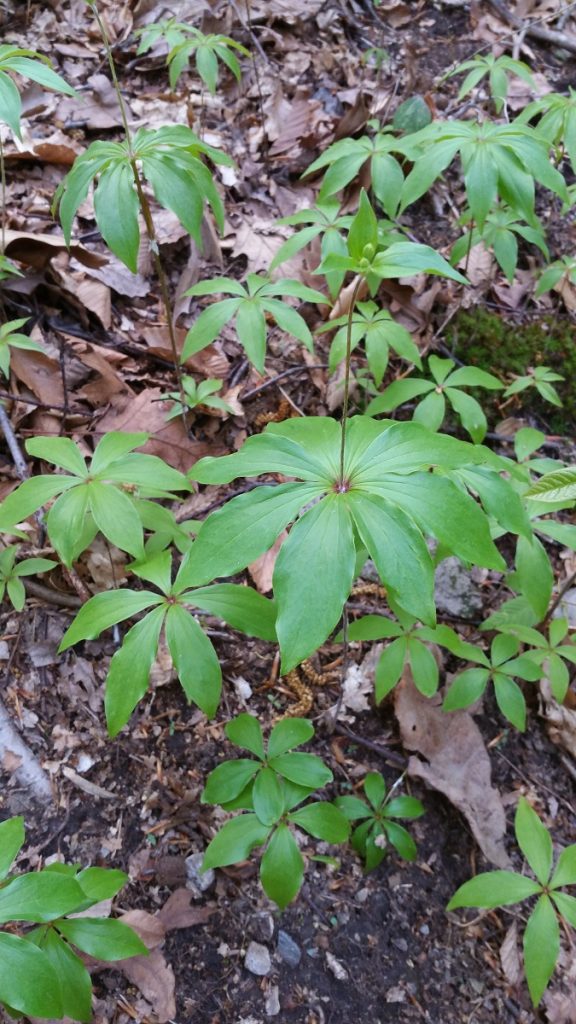
The lily family (Liliaceae) contains many plants that make for excellent edibles, and cucumber root (Medeola virginiana) is no exception. Cucumber root gets it’s name from its flavor — very much like cucumber, but sweeter. The leaves have a flavor also like cucumber. All parts of the plant may be eaten raw or cooked, with a caveat regarding the berries (although non-toxic, they have a taste which may not be the most palatable in the world to us of human persuasion).
The roots of cucumber root are generally fairly small, rarely but occasionally approaching the size of a finger. They have a texture that is firm and crisp. The humble cucumber root, Medeola virginiana, is a slow-growing, long-lived perennial ranging in size from about 3 inches to nearly 30 inches. It is the only species in its genus, one of its closest relatives being the genus Clintonia.
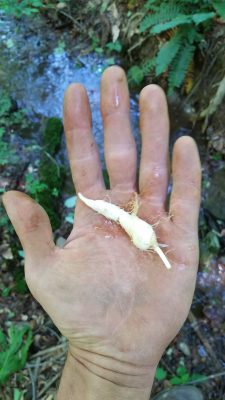
Medeola virginiana reproduces in two ways. The first way is vegetatively, through underground root-stems called stolons emerging from out of the fattened tuber-like portions of the rhizome or rootstock. When reproducing vegetatively, each fattened tuber-like rhizome produces one, two, or sometimes three lateral stolons in a year. As these stolons send up new suckers with above-ground leaves that start sucking up sunlight of their own in following years, they begin fattening up the area beneath their own portion of rhizome. At this point the stolons may be severed and you’ll effectively have two clonal versions of the plant.
The other way this plant reproduces is sexually, through the production of seed. Medeola virginiana however seems highly-dependent on cross-pollination between genetically individual plants in order to get good fertilization and seed-production, and therefore I believe that populations lacking genetic diversity produce little if any seed at all. *
* (As evidence I could point to the size difference between the stamens and the pistils, the stamens being the much shorter of the two. Called dichogamy, this is a physical mechanism discouraging self-pollination and thus inbreeding.)
Restoring diversity to cucumber root patches is part of the work of ecological restoration. Where I come from, hardly any of the cucumber root patches that I know produce much in the way of berries come late summer. Instead, what I find are relatively small patches which are largely clonal — reproducing for years primarily in a vegetative way. In a region where many of our forests are relatively young and stand before a legacy of clear-cutting, selective timbering, agricultural grazing (or even excessive deer-browse pressure), a lack of genetic diversity in our cucumber root stands is the result of human environmental degradations either directly or indirectly.
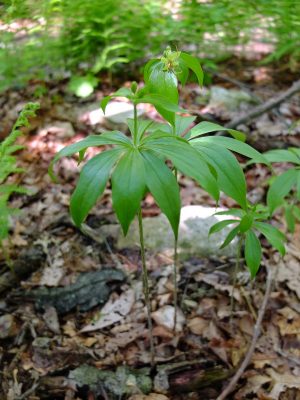
Medeola virginiana — the cucumber root — first emerges out of the ground in the early spring about March or April. With its neat symmetry it is very attractive and beautiful (surely one of my favorites).
Younger, sexually immature cucumber root plants grow above the ground only as a downy stem with a whorl of green lanceolate leaves at the apex. In older plants, those which are sexually mature, a second and smaller whorl of leaves grows above the first one on an elongated stem.
Appearing by late May or June as just a cluster of tiny, round, unopened buds above the smaller secondary whorl of leaves, these are the first signs of flowering. As the buds open to reveal pale-yellow flowers, the pedicels (or stems of the flowers) droop, dangle, or “nod” beneath the top whorl of leaves. Eventually the flowers will curl back upwards again (perhaps after they have been pollinated). And they remain in the upward position above the leaf whorl as the fertilized flowers turn into berries that ripen to the color dark blue-black.
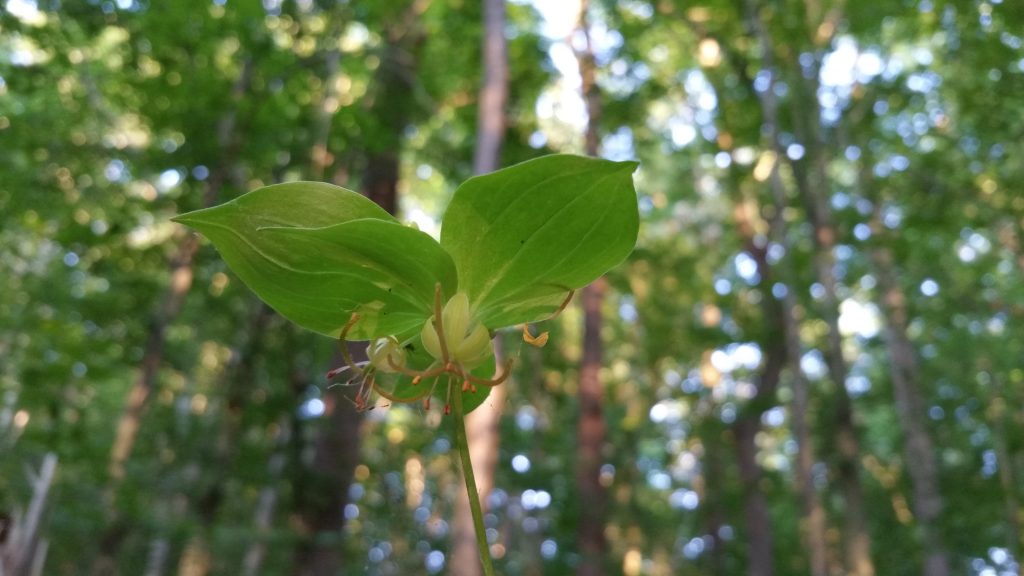
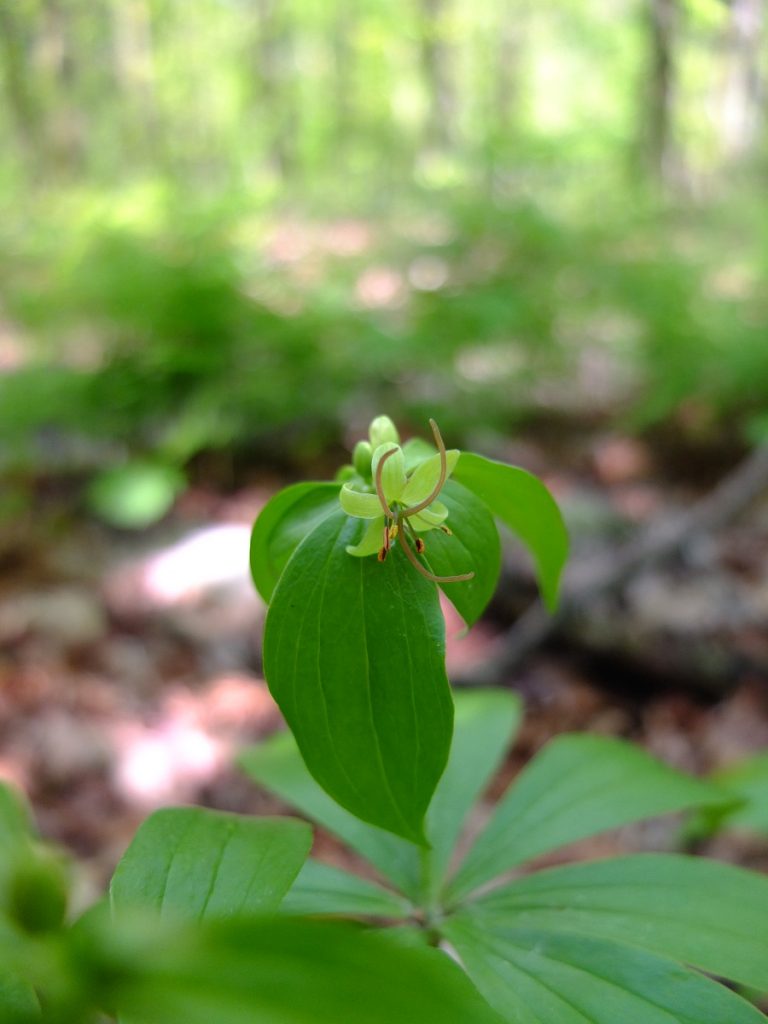
As the berries ripen from green to black, the apex of the plant turns a crimson red (on the flower pedicels and inner leaf margins). This perhaps serves as a guide to birds or other animals, who flying and flitting about through the forest canopy may notice these red centers as target signs, like a bulls-eye guidepost, creating contrast against the black berries and leading to a meal.
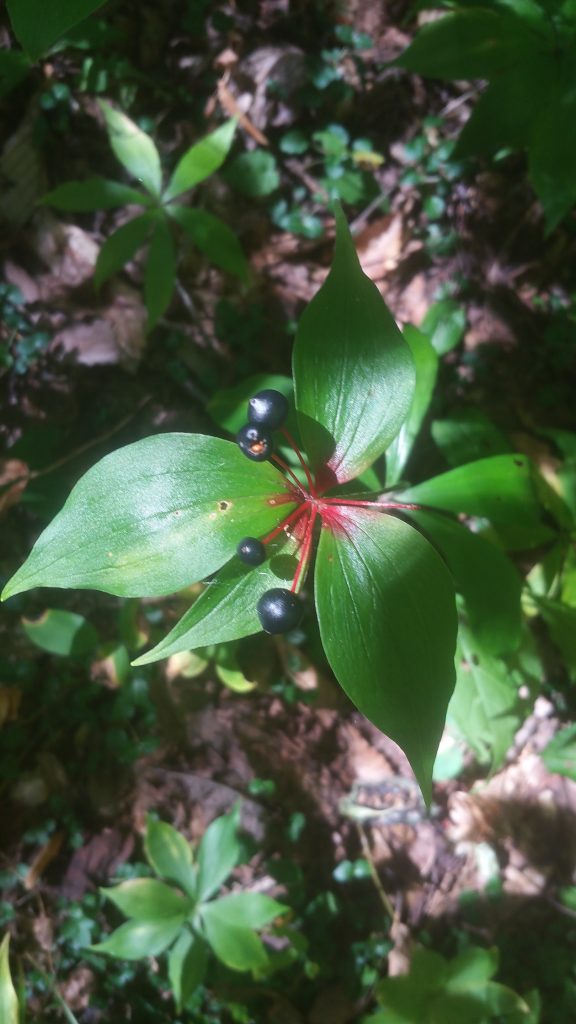
The berries ripen in August or early September. Without predation, the berries will sometimes remain upon the plants until they dry out and split, or fall to the ground of their own accord.
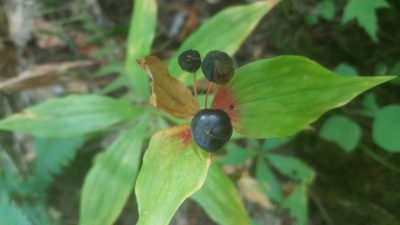
Inside each berry is anywhere from 2-6 hard, mahogany-colored seeds. If planted fresh they may sometimes germinate the following spring, but in many instances they adopt a strategy of double-dormancy, waiting 18 months or until after the second winter before deciding it is safe to emerge.
The seeds may be stored cool and dry without losing much viability, although like many of our eastern woodland herbaceous perennials, it is generally advisable to sow them quickly, rather than hold onto them for awhile.
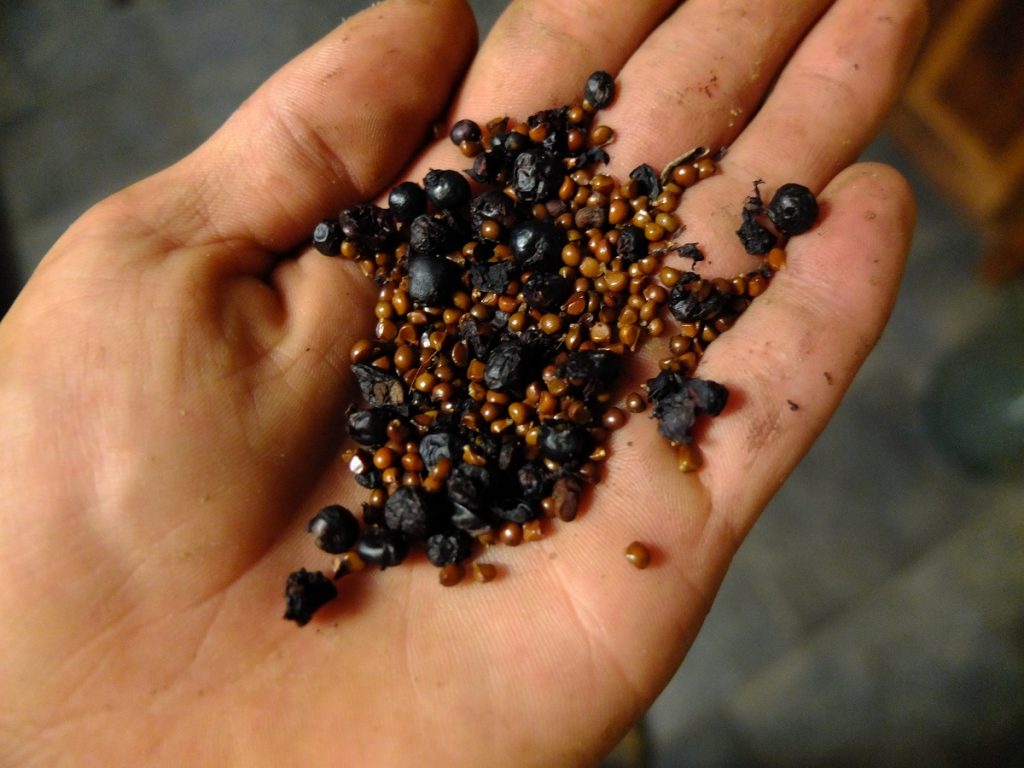
The cucumber root seems to prefer slightly-dry, acidic soils underneath a woodland canopy, where it is found most abundantly. They may thrive under a deciduous canopy (where the leaves drop off in the fall and grow back in the spring) or under a mixed canopy of deciduous and evergreen species together. In the wild it is often found on the up-slopes above the moister, wetter soils where more mesic species thrive down in the ravines and valleys and coves. However, the cucumber root is not confined strictly to these drier part of the hillsides — it is also found growing in the valleys and the coves and in moister, boggier areas.
I harvested my Medeola virginiana seed in areas where a high-level of population diversity was present, and the cucumber root grew almost as a continuous groundcover for several acres and along certain elevation gradients, forming a band of herbage encircling the mountains.
Cucumber root hates begin transplanted and once dug, it will in most cases wilt and go dormant immediately, emerging again only in the following spring. And though it expresses a preference for slightly-dry soils, Medeola virginiana is sensitive to too much light and will die in full-sun or mostly-sun conditions.
I don’t have numbers yet of exactly how many years it takes Medeola virginiana to grow through it’s entire life-cycle, from seed to flower, but my guess is that it is in the same category as the slow-growing trilliums and wild leeks. As a rule of thumb, expect two years for germination, and another five years until the plant begins flowering: all-in-all, a roughly seven-year investment.
Where cucumber root grows uncommonly and in small patches, and because it is a sensitive and slow-growing plant, it is advisable not to dig or harvest the roots for food at all. With careful tending and population management through the intentional gathering and planting of seed, Medeola virginiana may be restored to a place of abundance and healthy diversity within our forests, and from there it can serve as a food-source for pollinators and people in coming generations.
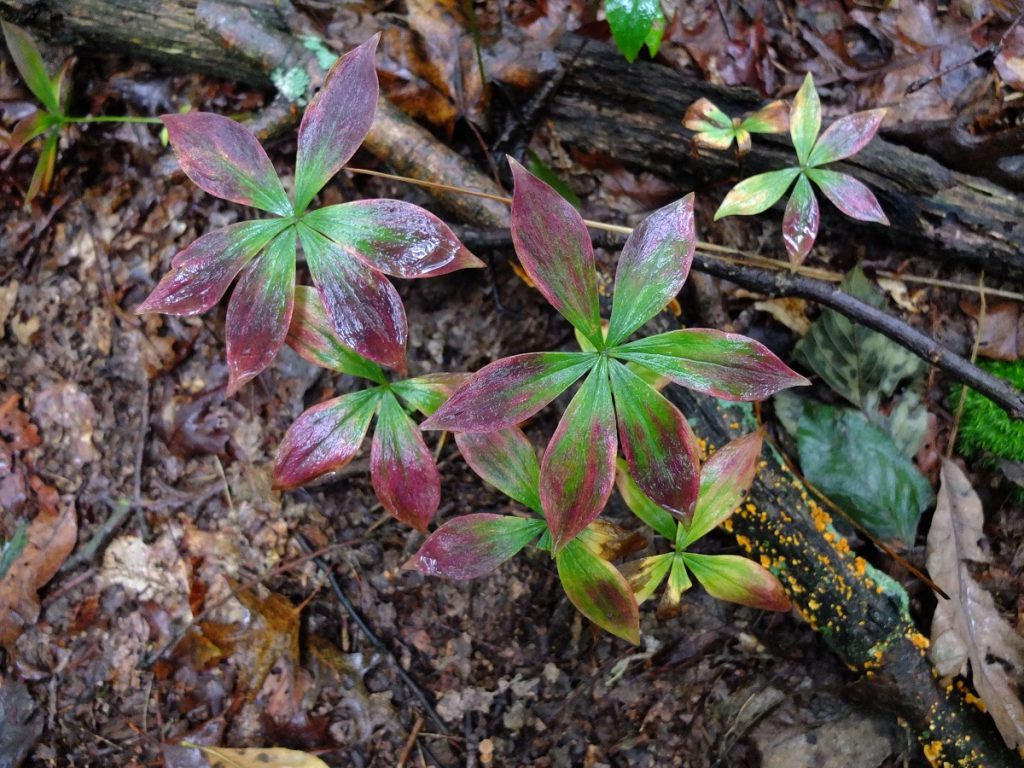
Would you consider selling 15 to 25 seeds of Indian cucumber root?
Unfortunately all of last year’s seed has been sown, but you can check back with me in fall. — Zach
Best information I could find to help me preserve our very small natural patch… thank you so much. I love this plant!